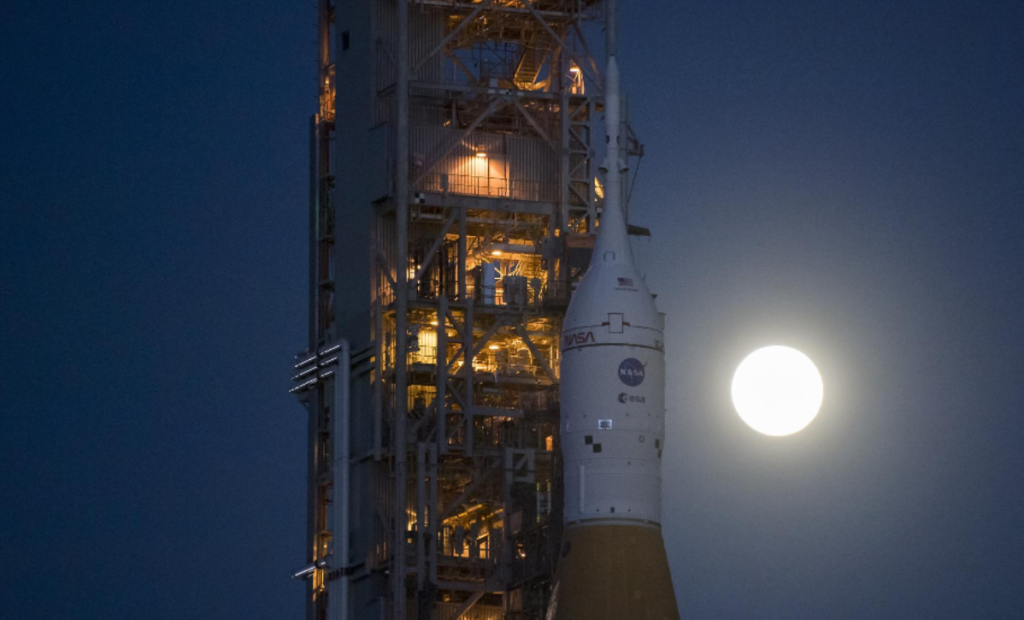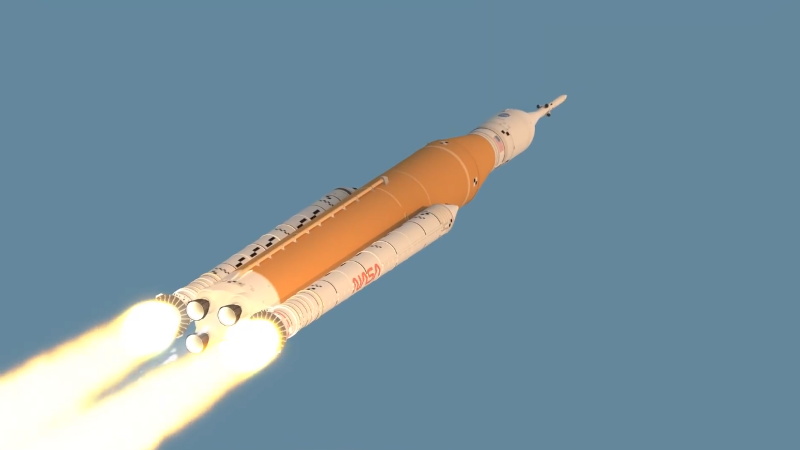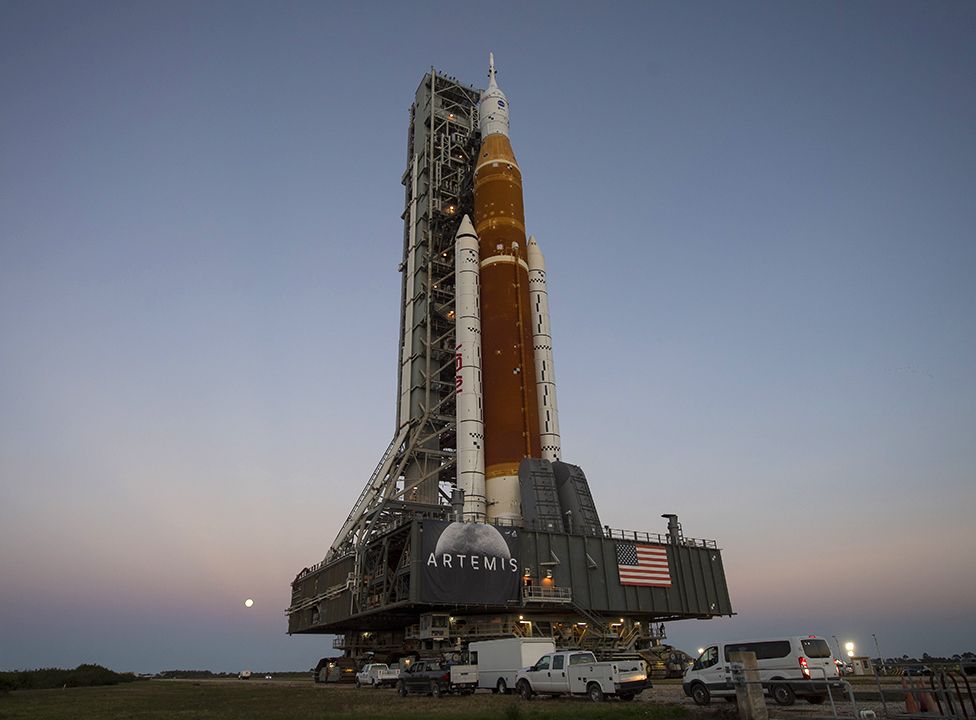
The Space Launch System Will Soon Return To The Pad
Many of us have been waiting patiently as NASA continues to work towards returning humans to the Moon apart of Artemis. At the core of many of these future missions is the Space Launch System or SLS rocket. This is one of the most powerful launch vehicles in the world expected to transport humans and cargo to and from the Moon.
Over the past few years and recent months especially, NASA has been working on SLS to prep it for an upcoming first orbital test flight this summer. The Space Launch System began its wet dress rehearsal around early April and experienced a few complications along the way. Since then it returned to the VAB for repairs and is expected to return to the launch pad not long from now.
It is necessary that NASA finds and fixes any problems with the launch vehicle during tests rather than actual launches. This being said, the long delays added to the wet dress rehearsal are pushing back the date of the first orbital test flight. Here I will go more in-depth into the state of SLS repairs, and when we should expect the rocket to return to the pad to finish the wet dress rehearsal.
Recent Updates

The past few weeks have been very busy for the Space Launch System. What was originally intended to be a two day test has turned into an over month long event. This being said, it’s important that NASA works out any issues now rather than on launch day. Specifically, after being returned to the VAB just a few weeks ago, NASA worked to fix the multiple problems that arose during the wet dress rehearsal. On May 9th, NASA tweeted saying, “Inside the Vehicle Assembly Building, the NASA Ground System team is working to prepare @NASA_SLS and @NASA_Orion for their journey back to Launch Complex 39B for the next wet dress rehearsal attempt.” Not only this, but a few days ago they provided another update mentioning, the “NASA Ground System is progressing well inside the Vehicle Assembly Building on #Artemis I. As we look to go back to the pad with @NASA_SLS & @NASA_Orion, remember these are minor issues and the team has done remarkable with this new, complex system.” Its clear the agency is working to make progress, and trying to ensure that after returning SLS to the pad for the second time, everything goes according to plan.
In addition to these tweets, the agency gave a more in-depth update on the progress. Since returning to the Vehicle Assembly Building (VAB), ground systems teams have worked to prepare the Artemis I Space Launch System (SLS) rocket and Orion spacecraft to roll back to Launch Pad 39B in late May to complete the wet dress rehearsal test in the early to mid-June timeframe. Inside the VAB at NASA’s Kennedy Space Center, engineers replaced a faulty helium check valve on the interim cryogenic propulsion stage that was identified after the second wet dress rehearsal attempt. Engineers inspected the valve and found a small piece of rubber that prevented the valve from sealing correctly. From here teams worked to look at possible sources of the debris, but did not see any issues with the valve itself, and planned to test the newly installed valve later to confirm it is operating as expected.
Engineers also performed tests to address a hydrogen leak on one of two tail service mast umbilicals between the mobile launcher and the rocket. These umbilicals provide liquid oxygen and liquid hydrogen propellants, as well as electrical connections, from the mobile launcher to the rocket’s core stage during the launch countdown. Teams conducted leak checks on all the joints and tightened several flange bolts, or fasteners that act as a washer to increase the compression strength, that can loosen over time and were the most likely source of the leak. Teams re-tightened the flange bolts on the liquid hydrogen, liquid oxygen, and core stage intertank umbilicals. Engineers have not detected leaks in subsequent testing at ambient air temperature, and will continue to monitor for leaks when loading the super cold propellants at the launch pad. The supplier that provides gaseous nitrogen for operations during tanking is upgrading its facility to meet the requirements for the next wet dress rehearsal attempt and the Artemis I launch. During the test, teams pump gaseous nitrogen into dry structures to protect avionics during propellant loading. Once all major work is completed, teams will retract the working platforms and prepare the integrated SLS rocket and the Orion spacecraft for the second journey to the launch pad.
As time went on, teams at NASA’s Kennedy Space Center in Florida continued to work on the main tasks needed to prepare the Space Launch System (SLS) rocket and Orion spacecraft to return to launch pad 39B for the next wet dress rehearsal attempt. After re-tightening the flange bolts on the tail service mast umbilical lines to address a hydrogen leak identified during the previous wet dress rehearsal, engineers determined the seals on the bolts are no longer relaxing, and the system should remain tightly sealed during propellant loading. As a precaution, teams also moved the location of a heavy cantilevered filter on the tail service mast umbilical, which filters out any contaminants in the gaseous helium – a purge gas – that travels through the drain assist purge line. Engineers did not identify any leaks at its previous location, but relocating the filter will ensure it does not contribute to future leaks. Engineers conducted additional leak checks and have not detected any leaks at ambient air temperature.
Additionally, after replacing the helium check valve on the interim cryogenic propulsion stage (ICPS), engineers found a damaged rubber O-ring seal in the flight side of the quick disconnect – the area that separates the ICPS from the mobile launcher during launch. The O-ring came loose and entered the valve, preventing the valve from sealing correctly. Teams removed the flight and ground side of the quick disconnect system and replaced support hardware that was downstream of the check valve. Work is underway to determine the root cause to prevent any recurrences. Next, teams will re-pressurize the system and test the replaced hardware on the upper stage. The supplier for gaseous nitrogen completed upgrades to its facility to meet the requirements for the next wet dress rehearsal attempt. Engineers will test the system next week to ensure its ready to support tanking operations. During wet dress rehearsal and launch, teams pump gaseous nitrogen into dry structures to protect avionics during propellant loading.
Future of SLS

Now that we know the extent of the Space Launch System’s repairs and what needs to be fixed, we can take a closer look at the future of the launch vehicle. NASA points out that teams also completed additional work needed, such as inspecting the Orion spacecraft for water damage that may have occurred during a heavy thunderstorm at the spaceport during the initial wet dress rehearsal attempt. Teams determined there was no damage to the systems inside the capsule and continue with inspections and wrapping up other work before retracting the platforms inside the Vehicle Assembly Building (VAB) to prepare to roll SLS and Orion back to the launch pad. NASA said they will announce dates for rolling out to the pad and the next wet dress rehearsal attempt once work inside the VAB and testing of the nitrogen system are nearing completion. Based on additional information from the agency and the current progress of the repairs, we can expect SLS to return to the launch pad in late May to early or mid June. Unfortunately, it seems that a decent amount of work is still needed which will push back dates for future tests. This includes the long-awaited Artemis 1 launch.
Artemis I, will be the first integrated test of NASA’s deep space exploration systems: the Orion spacecraft, Space Launch System (SLS) rocket and the ground systems at Kennedy Space Center in Cape Canaveral, Florida. The first in a series of increasingly complex missions, Artemis I will be an uncrewed flight test that will provide a foundation for human deep space exploration, and demonstrate our commitment and capability to extend human existence to the Moon and beyond. During this flight, the spacecraft will launch on the most powerful rocket in the world and fly farther than any spacecraft built for humans has ever flown. However, it needs to be fully repaired before this mission eventually happens.
Conclusion
For the first time in nearly half a century, we are getting very close to returning humans to the Moon. One of the most important factors is SLS or the Space Launch System. This rocket is one of the most powerful in the world and is intended to transport humans and cargo to and from the Moon. Over the past few weeks, it has been in the VAB working on repairs after a few issues were found during the wet dress rehearsal. NASA will need to fix any issues soon in order to launch the rocket for the first time later this summer a part of Artemis 1. We will have to wait and see how it progresses and the impact it has on the space industry.
